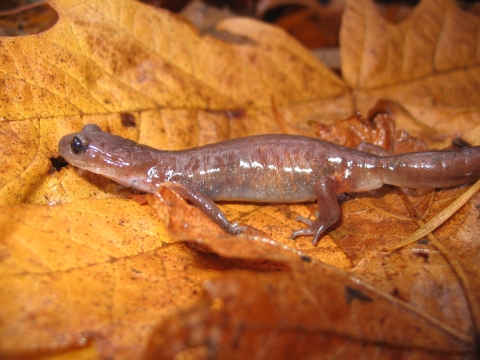Frogs, toads, and salamanders, Oh My! Populations of amphibians all over the world are decreasing. There are many easy ways you can help them out by making your home a safe and healthy home for them. When you invite amphibians into your yard you gain your own natural garden pest controls because slugs and other bugs are on their menu. Water features and moist environments are necessary for our fair-weather friends, providing safe and cool places to hide.
Reptiles also are a great addition to your yard! Not only do they keep bug pests in check, but they help manage rodent populations. Plus, they offer you a scaly glimpse from time to time as they sun themselves in an open patch of your yard, or while they stake out their territory on your fence.
Learn how you can make your home a safe and healthy home for reptiles and amphibians.
Create a water feature in your yard to provide a home and drinking water for wildlife.
While providing a valuable water source, you will also offer a breeding place for bugs like damselflies, which help control mosquitoes and are a great food source for amphibians, reptiles, as well as bats and birds! While you’re at it, make sure you support the preservation of wetlands in your community so, in addition to your pond, amphibians and reptiles have more homes.
Downed logs provide great habitat for all kinds of wildlife, including reptiles and amphibians!
Salamanders and Western tree frogs live inside the wet, rotting wood of downed logs. Toads, snakes, and lizards also seek shelter under logs. Bugs find homes inside or underneath the wood which, in turn, feeds reptiles and amphibians. If well planned and maintained, downed logs and wood features can be an attractive addition to your landscaping.
There’s no need to mow everything!
One of the easiest and most cost-effective ways to create a wildlife-friendly habitat is to leave sections of your lawn un-mowed or create a “wild” zone. Many animals, including reptiles and amphibians, use tall grass or a plant patch to hide and travel safely through your garden. “Wild” areas don’t need to be unsightly; try planting some native grasses or wildflowers, adding a rock border, or give it some character by adding a sign explaining to passersby why your garden is “wild.”
If you live in fire-prone areas, make sure you follow Firewise Recommendations.
Leave leaf litter and provide the damp habitat many creatures need!
In turn you will help bugs, like worms and centipedes, and amphibians like frogs and salamanders, stay safe and happy. Reptiles like snakes and lizards will seek shelter under the leaf litter. All sorts of animals also love eating the many bugs that live in the leaves, including reptiles and amphibians.
Create a home for wildlife by landscaping with a rock or a wood feature!
This cost-effective landscape design provides homes for bugs, reptiles (full sun), and amphibians (low sun and damp earth). In turn, both species love eating the many bugs.
Outdoor cats are one of the biggest dangers to native wildlife!
Billions of wildlife species around the world are killed each year by free roaming cats, including reptiles and amphibians. Native wildlife, like coyotes and raccoons, can also put your outdoor cat in harm’s way. To protect native wildlife and your cat, keep your furry friend indoors or build a protected catio.
Bugs are on the menu when it comes to reptiles and amphibians.
Here’s how you can keep the food coming:
- Start by choosing to not use pesticides, or use less toxic forms of insect control
- Grow native plants for native insects
- Plant for pollinators by landscaping with flowers throughout the blooming season
Learn more: Backyard Bugs Flyer







